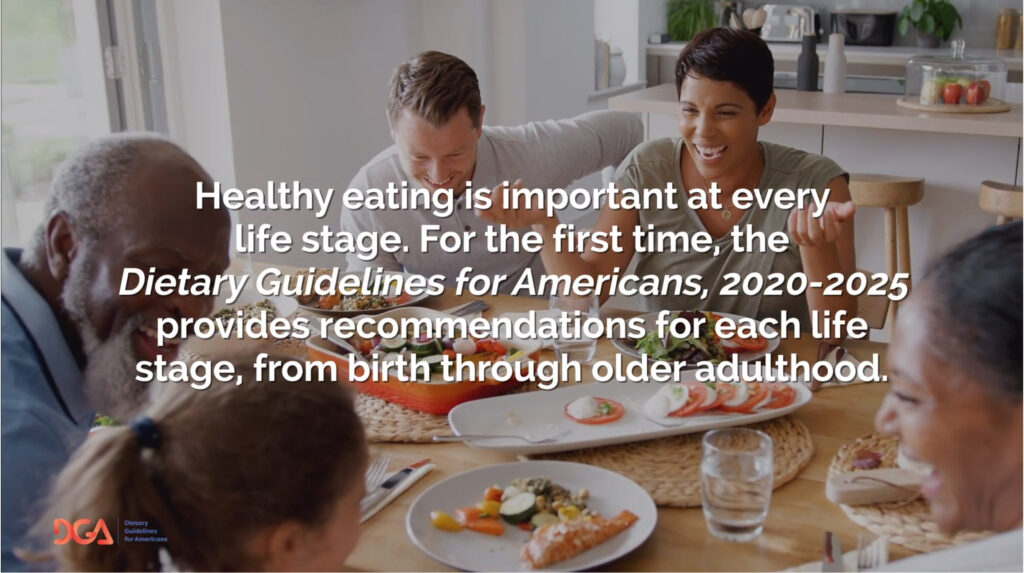Seafood has essential health benefits for every life stage – from infancy through to healthy aging. Learn more about the new 2020-2025 Dietary Guidelines for seafood.
Every 5 years the U.S. Department of Health & Human Services and the U.S. Department of Agriculture convene leading nutrition scientists and researchers to review the latest nutrition science, resulting in a new set of Dietary Guidelines for Americans. Nutrition science is always evolving, and we are constantly gaining more insight into the benefits of specific foods and nutrients. And, what’s great about seafood is the science just keeps getting stronger and stronger about the benefits of eating fish and shellfish for your health. Here at SNP, we have made it our mission to give you the tools needed to add more seafood to your plate and we’re here to break down the highlights of the 164-page Guidelines.
The Dietary Guidelines for Americans (DGA) provide science-based advice on what to eat and drink to promote health, reduce risk of chronic disease, and meet nutrient needs. This edition places more emphasis on nutrition for the individual. We are not a one-size-fits-all and that we each have unique nutrient needs, personal preferences, cultural and budgetary considerations. It also looks at different nutrient needs at different times throughout your life – or throughout “life stages.”
We know that what people eat and drink have an impact on their health. In the U.S., more than half of all adults have one or more preventable chronic diseases, many of which are related to poor diets and not enough physical activity. Given the high rates of chronic disease among Americans, the science that informs the Dietary Guidelines is examined through the lens of health promotion and disease prevention.(1)
Nutrition Guidance by life stages
New in this iteration of the DGAs is the life stage focus, providing age-specific nutrition guidance from birth through adulthood. Here are the latest seafood recommendations:
 For pregnancy
For pregnancy
“Seafood intake during pregnancy is recommended, as it is associated with favorable measures of cognitive development in young children.”
Pregnancy is an important time for optimal nutrient intake. Eating fish during before, during and after pregnancy – whether canned, cooked from frozen or fresh – is a good way to get the nutrients you and your baby need. At least 8-12 ounces of seafood per week is recommended, especially fish higher in omega-3 fats, as it is associated with favorable measures of cognitive development for your baby. The Dietary Guidelines Advisory Committee Scientific Report, which is the scientific backing for the Guidelines, said:
- Seafood consumption before pregnancy may be related to reduced risk of gestational diabetes and hypertensive disorders.
- Consumption during pregnancy may be related to reduced risk of hypertensive disorders and preterm birth and better cognitive development and language and communication development in children.
- Women who are lactating should continue to consume seafood at the same amounts recommended during pregnancy.
Infancy
Starting at about 6 months of age, the DGA says to introduce iron- and zinc-rich foods, such as fish and shellfish. Seafood is an important source of “iron, zinc, protein, choline, and long chain polyunsaturated fatty acids … needed for the rapid brain development that occurs through the infant’s first 2 years of life,” states the DGA. “Some types of fish such as salmon and trout are also natural sources of vitamin D.” Introducing these foods early in life can also lower risk of food allergies.
 Women & Men
Women & Men
For the adult general public, the seafood consumption recommendations remain the same as from the previous Dietary Guidelines for seafood – 8 to 12 ounces per week, now based on daily caloric intake. Choosing a variety of seafood just twice a week meets these recommendations.
Seafood is an important source of essential omega-3 fatty acids, which can help reduce inflammation in the body, which is the root of many chronic diseases. This is especially true as it related to healthy aging.
Linda Cornish, president of SNP said, “Americans are still falling short of consuming the recommended amounts of seafood and we are hopeful that the launch of the DGA 2020-2025 will bring a renewed sense of urgency for Americans to include more seafood into their diets for its great taste and important nutrients.” From delicious recipes to the latest science we have resources to help you meet the Dietary Guidelines for seafood and improve your overall health.
We want every American to benefit from this delicious nutritional powerhouse.



Leave a Reply